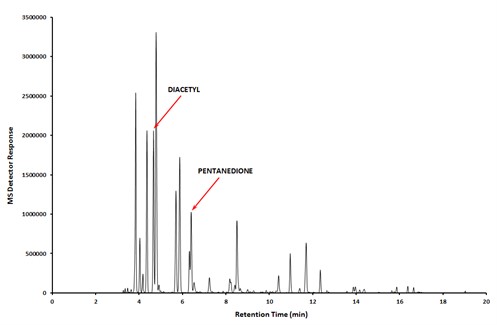Diacetyl in Coffee Manufacturing

The Challenge
Diacetyl is a naturally occurring substance with a butter-like
odour which is present in many foods. NIOSH (National
Institute for Occupational Safety & Health) in the USA reported
a link between exposure to vapours containing diacetyl and
decreased lung function and disease. Most studies have
concentrated on exposure to diacetyl in the flavouring industry,
but recent reports have also highlighted the possibility of
exposure to diacetyl, and the related compound 2,3-pentanedione, in
coffee manufacturing, particularly roasting and grinding.
Currently there are no Workplace Exposure Limits (WELs) for either
diacetyl or 2,3-pentanedione but the European Commission Scientific
Committee on Occupational Exposure Limits (SCOEL) has recommended
an 8-hour time-weighted average (TWA) limit for diacetyl of 20 ppb
(parts per billion) and a 15-minute short term exposure limit
(STEL) of 100 ppb (
SCOEL, 2014). However, there is a lack of information on
airborne concentrations of these substances in the coffee
manufacturing sector making it difficult to assess the potential
for personal exposure in their workforce.
The Solution
Most of the methods currently available for measurement of
diacetyl are awkward to use, particularly for personal sampling,
and lack the sensitivity to be able to measure diacetyl and
pentandione down to ppb levels. HSE therefore developed a
sampling and analytical procedure utilising well-proven sorbent
tube and thermal desorption technology. This method is
capable of detecting the presence of both compounds down to sub-ppb
concentrations. In addition to pumped sampling, HSE
determined diffusive uptake rates for diacetyl and pentandione
which allows the sampling devices to be used to take passive
(diffusive) samples. Passive samples are well suited to long
term and personal sampling as they eliminate the need for a
sampling pump. HSE used this new sampling method to carry out
monitoring of both diacetyl and pentanedione at coffee
manufacturing premises, using both personal and static
samples. Sampling was carried out in areas of the plant where
roasting and grinding of the coffee was being carried out, as these
were the areas where concentrations were expected to be the
highest, as well as the packing area and control room.
Post-sampling, the samples were analysed for the presence of
diacetyl and pentanedione by thermal desorption, gas chromatography
and mass spectrometry (TD-GC-MS).
The Outcome
The monitoring exercise showed that airborne concentrations of
diacetyl were above the proposed WEL. The highest concentrations
were found in the grinding area, but airborne concentrations in
excess of the 8-hr TWA limit were also detected in the roasting and
packing areas and in the control room. Pentanedione was also
detected, at a level of around a half to a third of those of
diacetyl. These results provide evidence that improvements are
required in order to control potential occupational exposure to
diacetyl and pentanedione in this particular workplace. The results
should also alert other coffee manufacturers to the possibility of
exposure of their employees to diacetyl and pentanedione and the
need for adequate control measures to prevent this and, more
importantly, the ill health that may occur as a result.
The initial work was funded by HSE, but this is now a commercial service
that we offer.
View more examples of our work in this
area.
Back to the top